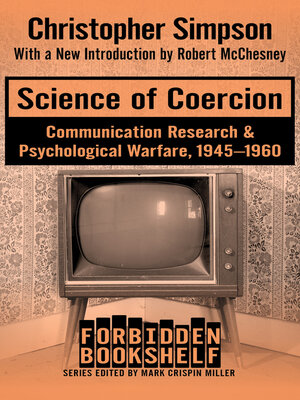Science of Coercion
ebook ∣ Communication Research & Psychological Warfare, 1945–1960 · Forbidden Bookshelf
By Christopher Simpson

Sign up to save your library
With an OverDrive account, you can save your favorite libraries for at-a-glance information about availability. Find out more about OverDrive accounts.
Find this title in Libby, the library reading app by OverDrive.



Search for a digital library with this title
Title found at these libraries:
| Library Name | Distance |
|---|---|
| Loading... |
A provocative and eye-opening study of the essential role the US military and the Central Intelligence Agency played in the advancement of communication studies during the Cold War era, now with a new introduction by Robert W. McChesney and a new preface by the author Since the mid-twentieth century, the great advances in our knowledge about the most effective methods of mass communication and persuasion have been visible in a wide range of professional fields, including journalism, marketing, public relations, interrogation, and public opinion studies. However, the birth of the modern science of mass communication had surprising and somewhat troubling midwives: the military and covert intelligence arms of the US government. In this fascinating study, author Christopher Simpson uses long-classified documents from the Pentagon, the CIA, and other national security agencies to demonstrate how this seemingly benign social science grew directly out of secret government-funded research into psychological warfare. It reveals that many of the most respected pioneers in the field of communication science were knowingly complicit in America's Cold War efforts, regardless of their personal politics or individual moralities, and that their findings on mass communication were eventually employed for the purposes of propaganda, subversion, intimidation, and counterinsurgency. An important, thought-provoking work, Science of Coercion shines a blazing light into a hitherto remote and shadowy corner of Cold War history.







